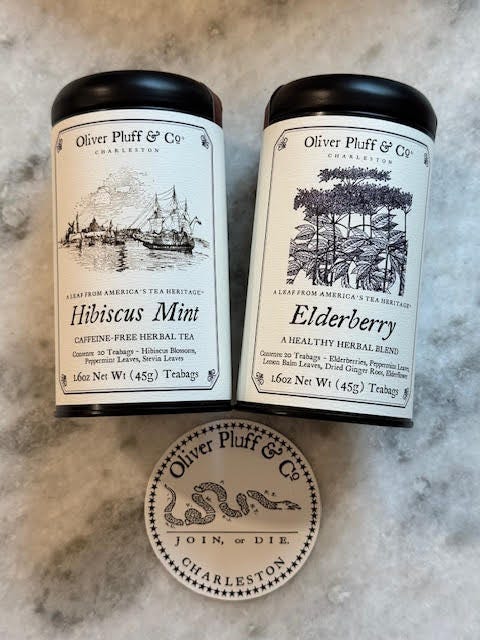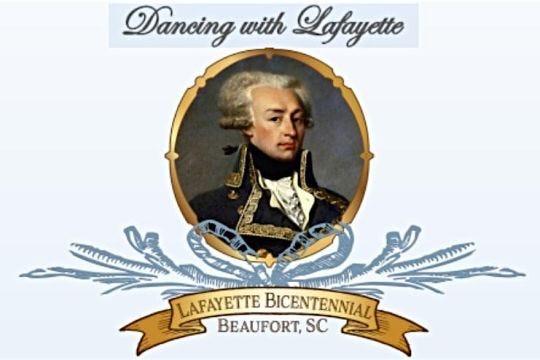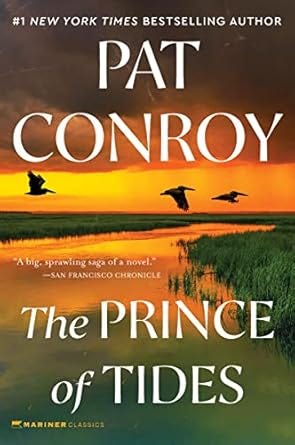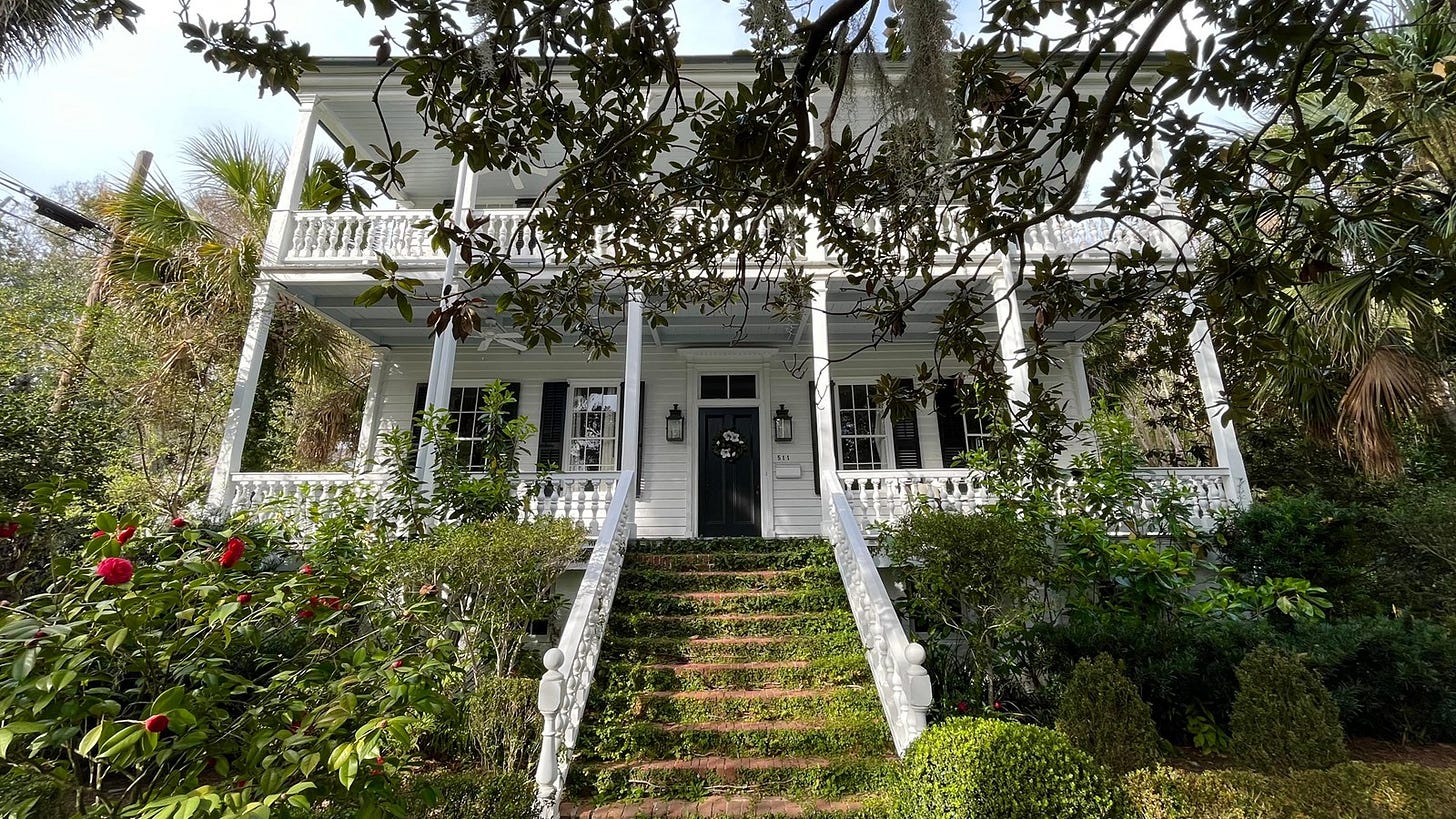#137: Historic Beaufort, Dancing With Lafayette, and The Prince of Tides
For South Carolina history lovers far and wide! Published weekly on Monday mornings. Enjoy weekly SC history articles, upcoming SC historical events, and other South Carolina recommendations.
Dear readers,
Welcome to SC History Newsletter #137!
Yesterday, my family spent the whole day in the garden — getting the beds ready for spring and tidying up our backyard. It was so much work, and I’m very sore today, but it was wholesome and lovely to be outside in the dirt together — me, my husband, and my 12-yr-old stepson. My stepson and I found snails, centipedes, colonies of ants, worms, and other creatures that made us smile. Spring is my 2nd favorite season in South Carolina (Fall #1!) and we are so close to the joy of green leaves galore, flower blossoms, and mild temperatures again. Can’t wait!
Another activity that brought me joy this week was steeping multiple cups of Oliver Pluff tea for myself! Specifically the Elderberry Tea and Hibiscus Mint teas. Yummm.
If you didn’t get to read last week, Oliver Pluff & Co. is our first sponsor of the SC History Newsletter (woohoo!!) and is a Charleston-based supplier of heritage teas and coffees from America’s past. They have such wonderful branding and the tea is simply delicious. See two photos below from my kitchen. Need a fun South Carolina/American-history themed hostess gift? Oliver Pluff & Co teas would be perfect!
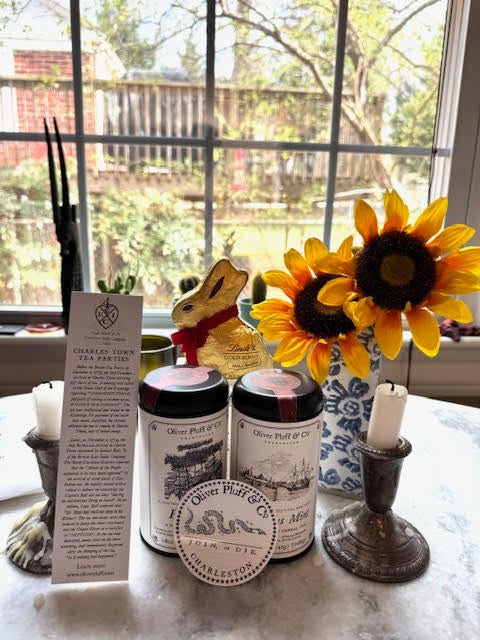
On the newsletter front, I had fun taking us on a virtual tour of historic homes in Charleston last week, so this week, I thought I would take us on a historical tour of Beaufort, SC — a city I have not yet been to, and that has fascinated me since I moved to South Carolina. Must go soon!
Are any of you from, or live in, Beaufort? Please write to me and tell me more about the city and any historical elements you love most.
As an aside, I am also thrilled to see a handful of historical organizations in South Carolina celebrating the 200th anniversary of General Marquis de Lafayette’s farewell tour to the United States. Lafayette is one of my all-time favorite Revolutionary historical figures. It’s a bit late notice, but below I highlight an exciting and festive event in Beaufort commemorating Lafayette’s bicentennial as well.
Now let’s learn from SC History!
Yours truly,
Kate
(Writing from Greenville, SC)
➳ Housekeeping for new subscribers!
New friends! Please note that there are over 100 previous SC History newsletters on topics ranging from the founding of Charleston, sunken Confederate submarines, railroad tunnels filled with blue cheese, and more! See our archive here!
Send me your comments or topic ideas: I love it when subscribers write to me! Have a SC History topic or question you’d like for me to write about? Have additional ideas or feedback? Just reply to this email and let me know!
Join us on social: Keep the conversation going and join over 100 other subscribers by becoming a member of our SC History Newsletter Facebook Community here!
If your email “cuts off”: In your email app or website, if my emails “cut off” for you, please click the title of the email and it will take you to the full post on the Substack. I don’t want you to miss any content!
Love the SC History Newsletter? Please click the button below to share with a friend!
➳ Featured SC History Event of the Week:
Tuesday, March 18th from 5:30 - 8:00 pm | “Dancing With Lafayette” | Beaufort History Museum | Beaufort, SC | TICKETS: $40 | Website
As a perk for paid subscribers, click here or the button below to visit my full SC History Events Calendar that organizes all the upcoming SC history events I have discovered. Please let me know if you’d like to add an event to the calendar! Reply to this email to send me your events.
➳ Other SC History Recommendations
BOOK: “The Prince of Tides” by Pat Conroy
A South Carolina classic!
Publisher’s Book Summary:
“In this best-selling novel, Pat Conroy tells the story of Tom Wingo, his twin sister, Savannah, and the dark and violent past of the family into which they were born.
Set in New York City and the low country of South Carolina, The Prince of Tides opens when Tom, a high school football coach whose marriage and career are crumbling, flies from South Carolina to New York after learning of his twin sister’s suicide attempt. Savannah is one of the most gifted poets of her generation, and both the cadenced beauty of her art and the jumbled cries of her illness are clues to the too-long-hidden story of her wounded family. In the paneled offices and luxurious restaurants of New York City, Tom and Susan Lowenstein, Savannah’s psychiatrist, unravel a history of violence, abandonment, commitment, and love. And Tom realizes that trying to save his sister is perhaps his last chance to save himself.
With passion and a rare gift of language, Pat Conroy moves from present to past, tracing the amazing history of the Wingos from World War II through the final days of the war in Vietnam and into the 1980s, drawing a rich range of characters: the lovable, crazy Mr. Fruit, who for decades has wordlessly directed traffic at the same intersection in the southern town of Colleton; Reese Newbury, the ruthless, patrician land speculator who threatens the Wingos’ only secure worldly possession, Melrose Island; Herbert Woodruff, Susan Lowenstein’s husband, a world-famous violinist; Tolitha Wingo, Savannah’s mentor and eccentric grandmother, the first real feminist in the Wingo family.
Pat Conroy reveals the lives of his characters with surpassing depth and power, capturing the vanishing beauty of the South Carolina low country and a lost way of life.”
➳ SC History Topic of the Week:
A Virtual Tour Through Historic Beaufort
Originally founded by Scottish immigrants as “Stuart Town” in 1684, the settlement was taken over by the British and renamed Beaufort in 1711. The town was named for Henry Somerset, the second duke of Beaufort, and proprietor of Carolina from 1700-1714. Beaufort is the second oldest city in South Carolina after Charleston. While staving off Indian attacks in its early years, Beaufort became a regional center for the Lowcountry plantation economy up and through the Civil War. The city rebounded after the Civil War and in the latter half of the 20th century, became (and still is) one of the most beautiful and livable cities in the country. Here are some of the historical highlights of beautiful Beaufort, SC.
The Old Sheldon Church Ruins (c. 1745)

Located about 25 minutes outside of downtown Beaufort, this is known as a “must-see” Beaufort attraction.
The church was originally known as Prince William’s Parish Church and was built in the Greek Revival style between 1745 and 1753. It was one of the first churches build in a “temple form” in the United States.
The land for the church was donated by the Bull family from the original holdings of the first landowner, Edmund Bellinger, who “was awarded the lands by a patent dated May 7, 1698, promulgated by the Lords Proprietors.”
The name Sheldon Church was used in honor of the Bull family whose Carolina plantation and ancestral home in Warwickshire, England, were both called Sheldon Hall.
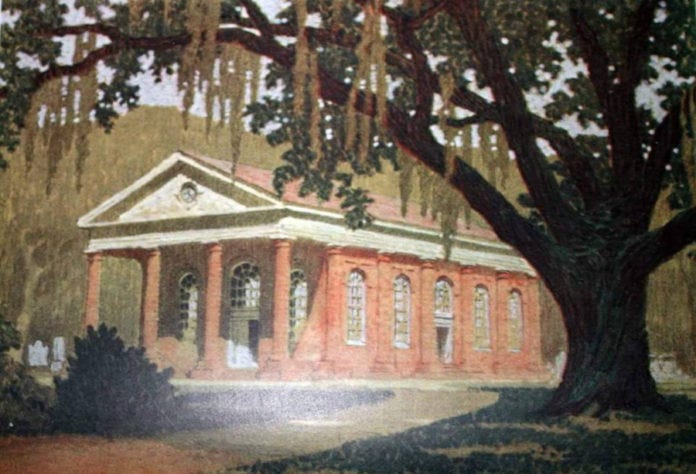
During the Revolutionary War, Sheldon Church was used as a “political and military center for the area” where arms and ammunitions were stored. It also served as a location for Continental troops to drill.
In 1779, the church was burned down by British General Augustine Prevost in during the Revolutionary War.
In 1826, the church was rebuilt, but tragically, it was burned down AGAIN, this time by General William Tecumseh Sherman’s army in February 1865.
The site was listed in the National Register of Historic Places on October 22nd, 1970.
From the County of Beaufort website:
“The ruins of the church still retain their classic simplicity. The original three-and-one-half foot thick colonnaded walls of Flemish bond and the four all-header bond portico columns remain. The western facade had an elegant portico, crowned by a triangular pediment with bulls-eye window and cornice with dentils. The large front doorway had a fanlight above and two round-headed windows, symmetrically spaced, on either side. On the north, five bays between the engaged columns were filled with a single tier of tall, round-headed windows. The other bay was left open for a portico. At the eastern end, above the alter, was a Palladian window, with a round-headed window on each side.”
Inside the ruins of the church is the burial site of Colonel William Bull who served as Lieutenant Governor of South Carolina and along with his brothers, was a commissioner for the building of Sheldon Church.
Per his gravestone at the Old Sheldon Church Ruins, Colonel William Bull also “assisted in laying out of Savannah” with James Edward Oglethorpe, the founder of the Colony of Georgia and what would become Savannah. Indeed, Colonel Bull was a “master surveyor” and assisted Oglethorpe in selecting the site and laying out the beautiful urban plan we know and love today in Savannah, Georgia.
Today, the majestic ruins (and beautiful historic trees) of the church grounds are often used as a romantic backdrop for weddings and other events.
Each year, an annual worship service is held in person at the Old Sheldon Church Ruins the 2nd Sunday after Easter.
Let’s take a tour of the Old Sheldon Church ruins together… :)
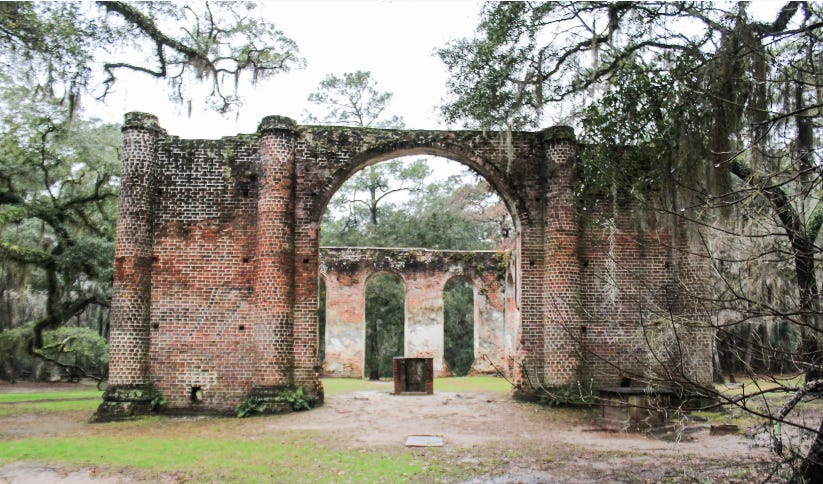
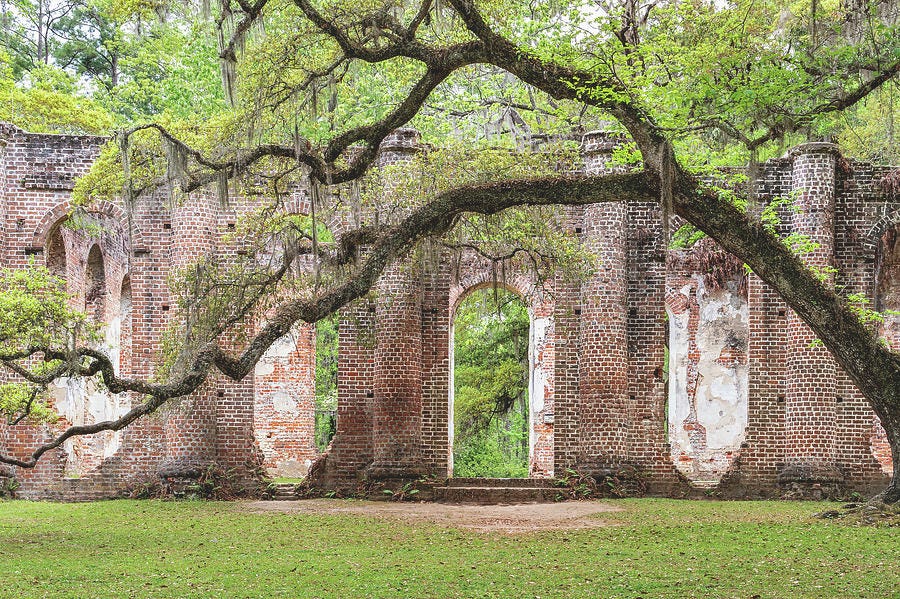
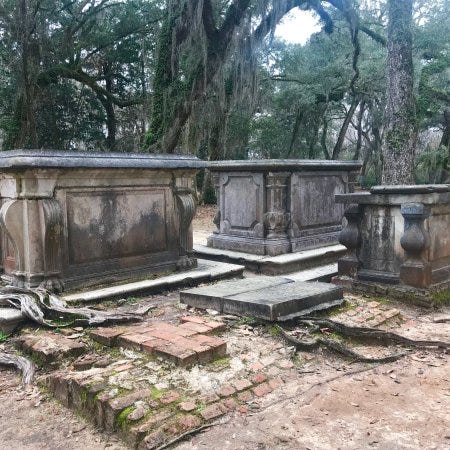
John Mark Verdier House (c. 1804)

Located at 801 Bay Street, at the corner of Bay and Scott Streets in the historic downtown, the John Mark Verdier House Museum is the only historic planter’s home open to the public in the city of Beaufort.
The 1804 estate “presents an accurate portrait of how Beaufort's wealthiest citizens lived during the height of the pre-Civil War Antebellum period.”
John Mark Verdier was a French Huguenot who came to Beaufort to build his fortune in the plantation business. The family focused on the lucrative indigo trade of the latter 18th and early 19th centuries.
By the 2nd half of the 1700s, John Mark Verdier had traded enough indigo to afford 1,000 acres of Sea Island cotton fields and plantations.
To represent his “rise in society” Verdier build a home in downtown Beaufort, close to the water. The home “cemented his ascent from the well-to-do merchant class to a wealthy member of Beaufort's elite.”
The home has two levels of white pillared columns supporting two level of front porches. It became a “local landmark from the get-go.”
In a lovely connection to our featured event above, in 1825, none other than the esteemed Marquis de Lafayette paid a visit and was entertained at the John Mark Verdier House on his American Southern Tour — 200 years ago!
Then, when Union Troops occupied Beaufort during the Civil War, they used the John Mark Verdier house as their headquarters.
The home was built using “era-appropriate shipbuilding techniques” with beams and hand cut boards laid horizontally. Apparently, this method was unusual for the time, but kept the house strong as it has weathered hundreds of years of storms and hurricanes.
It was the first Beaufort home to have a telephone.
While photographs are not allowed within the John Mark Verdier home, I found this beautiful photo of what appears to be the home’s entryway:


John Mark Verdier died in 1827, but the house was left to his son James Robert Verdier, who interestingly, was a pioneer in early research in the cure for the “deadly and prevalent-at-the-time” Yellow Fever.
The home was listed on the National Register of Historic Places in 1971 and was opened by the Historic Beaufort Foundation as a historic house museum in 1975.
Today, visitors can tour the home with professional tour guides Monday-Saturday. Learn more about tours on the Historic Beaufort Foundation website here!
The Robert Smalls House (c. 1843)
Located a 10-minute walk away from the John Mark Verdier House, at 511 Prince Street (between Duke and Prince) is the Robert Smalls House.
The house is not open to the public and is privately owned.
It was originally constructed by Henry Mckee, who was a slaveowner and originally owned the extraordinary South Carolina historical figure Robert Smalls and his mother as slaves.
See SC History Newsletter #72 here for Robert Smalls full life history!
Smalls was born a slave in 1839 at the Prince Street house to his mother Lydia Polite, who was also a slave.
In 1851, Smalls’ master Henry McKee began hiring out Smalls to work on various projects in Charleston. Smalls worked at a hotel and then as a lamplighter.
During those years working in Charleston, Smalls met Hannah Jones, who he married in 1856. The couple had 2 children.
Before the Civil War, Smalls worked aboard a transport boat known as “The Planter.” In one of the most extraordinary stories of the Civil War, Robert Smalls used The Planter to escape Confederate forces in Charleston Harbor and “self-emancipated himself and his family, as well as several other enslaved crewman” on May 13, 1862.
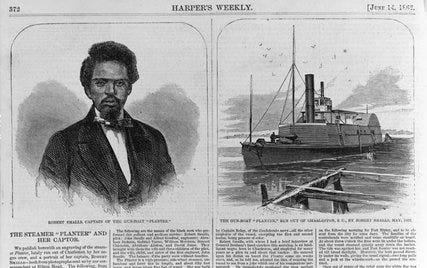
For his heroic act, Robert Smalls received a Congressional award of $1,500, which he used — in a most amazing twist of fate and fortune — to purchase the home at Prince Street where he and his mother were originally enslaved by the McKee family.
Robert Smalls purchased the home for $605 in January 1864 after the Civil War had ended. His mother lived with Smalls and his family until her death.
In a touching act of generosity, Robert Smalls also allowed his former enslaver’s wife, the elderly Jane McKee, to move into her former home for the remainder of her life as well.
Once back in Beaufort, Smalls pursued a career as a politician and won election as a Republican to the South Carolina Legislature and the U.S. House of Representatives during the Reconstruction Era. He was one of the founders of the Republican Party of South Carolina.
Here is a quote from Robert Smalls, speaking against the disenfranchisement of African Americans during the 1895 South Carolina constitutional convention.
“My race needs no special defense, for the past history of them in this country proves them to be equal of anyone. All they need is an equal chance in the battle of life.”
In 1974, the Robert Smalls House was designated a National Historic Landmark and in 2022 was listed on the Reconstruction Era National Historic Network.
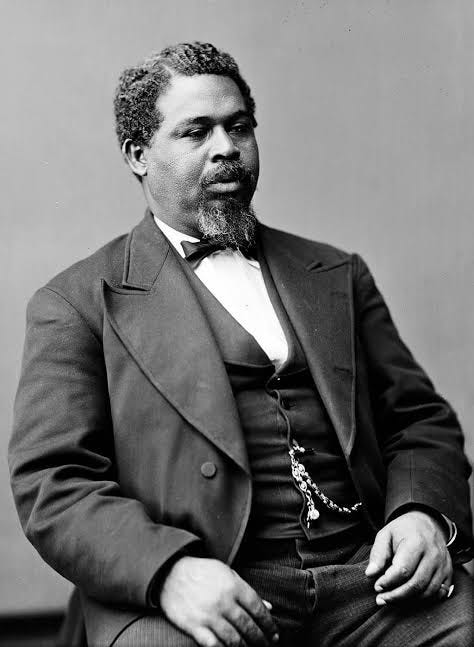
Robert Smalls (Image Source: Blackpast.org)
Penn Center (Founded 1862)

Located on St. Helena Island about 20 minutes outside of Beaufort is the Penn Center, which was founded in 1862 as one of the first schools in the south for freed slaves.
The Penn School has served as a community hub for “Black education, community welfare, and cultural heritage” for over 150 years.
The Penn School has functioned as an “educational institution, health clinic, farm bureau, catalyst for community action, and a repository for preserving St. Helena Island’s unique Gullah heritage and written history.”
After the Civil War, The Penn School was founded by missionaries and abolitionists from the North, who came south after the war with a top priority to educated formerly enslaved workers and their families. Classes for freedmen were “held in barns, cabins, and deserted plantation houses scattered across St. Helena.”
The only school to survive in the area was the Penn School, which was founded by Quaker abolitionists Laura Town and Ellen Murray on land purchased from Hastings Gantt, a freedman and entrepreneur.
With a nod to the Quaker history, the school took its name from William Penn, who was a champion of the Quaker denomination and founder of Pennsylvania.
A private Quaker charity based out of Philadelphia funded the Penn School in its early years.
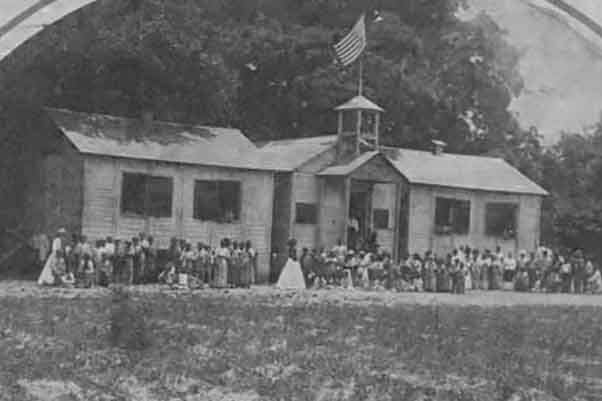
The school struggled after the Reconstruction Era, and two Northern, white educational philanthropists, Rossa B. Cooley and Grace House, took over leadership of the school. According to the National Park Service, in the years that followed:
“In addition to training students in masonry, carpentry, and the domestic arts, Penn School trained midwives and offered relief to St. Helena Island residents suffering from economic hardship during the Great Depression. Although the school closed in 1948, the community service and cultural preservation functions originated by the school’s founders flourished through Penn Community Services, Inc., organized in 1951. Penn opened South Carolina’s first day care center for African Americans, provided a community health care clinic, and began a Teen Canteen for local teenagers.”
In the 1960s, the Penn Center hosted interracial conferences and was at the forefront of the Civil Rights movement with groups such as the NAACP, CORE, SNCC, Southern Regional Council, and South Carolina Council on Human Relations.
Civil Rights leaders introduced Dr. Martin Luther King, Jr. to the Penn Center and he came to meetings at the Penn Center 5 times between 1964-1967.
The Penn Center and St. Helen Island in general “became a bastion of peace and a place of refuge” for Martin Luther King, Jr.
The Penn Center team even began constructing a cabin for King on the marsh for his future visits, but King was tragically assassinated before the cabin was completed.
In subsequent decades, Penn Center continued to serve as a site for church and organizational retreats, a training center for various organizations, and an educational site for Black history and culture.
In January 2017, President Barack Obama designated the Beaufort National Landmark District, Camp Saxton Site, Penn Historic District and the Old Beaufort Firehouse as the Reconstruction Era National Historical Park to preserve and commemorate activities during Reconstruction under management of the National Park Service.
Today, the Penn Center is a 50-acre historic district that includes 25 historic buildings and structures, and has a mission “to promote and preserve Penn’s true history and culture through its commitment to education, community development and social justice.”
There are self guided and docent-led tours of the Penn Center, Tuesday-Saturday each week. Click here for more information: https://www.penncenter.com/visit.
Have you visited any of these beautiful historic sites above in Beaufort? Tell us your stories and leave a comment below!
If you voted just “OK” on the newsletter today, I want to hear from you: what would you suggest I improve for next time? Please leave a comment below:
➳ Sources — A Virtual Tour Through Historic Beaufort
Beaufort County Government. Old Sheldon Church Ruins. Beaufort County Planning, https://www.beaufortcountysc.gov/planning/historic-sites/sheldon-church.html. Accessed 16 Mar. 2025.
Beaufort-SC.com. John Mark Verdier House. https://www.beaufort-sc.com/verdier-house.html. Accessed 16 Mar. 2025.
BeaufortSC.org. Old Sheldon Church Ruins. https://www.beaufortsc.org/things-to-do/attractions/old-sheldon-church-ruins/. Accessed 16 Mar. 2025.
Explore Beaufort SC. "Painting Sheds Light on Original Look of Sheldon Church." Explore Beaufort SC, https://explorebeaufortsc.com/painting-sheds-light-on-original-look-of-sheldon-church/. Accessed 16 Mar. 2025.
Edgar, Walter. Beaufort. South Carolina Encyclopedia, University of South Carolina, https://www.scencyclopedia.org/sce/entries/beaufort/#:~:text=(Beaufort%20County%3B%202020%20pop.,Carolina%20from%201700%20to%201714. Accessed 16 Mar. 2025.
National Park Service. Penn Center. U.S. Department of the Interior, https://www.nps.gov/places/south-carolina-penn-center.htm. Accessed 16 Mar. 2025.
National Park Service. The Robert Smalls House. U.S. Department of the Interior, https://www.nps.gov/places/the-robert-smalls-house.htm#:~:text=Originally%20constructed%20around%201840%20by,of%20the%20most%20influential%20African. Accessed 16 Mar. 2025.
National Register of Historic Places. Sheldon Church Ruins. South Carolina Department of Archives and History, http://www.nationalregister.sc.gov/beaufort/S10817707009/index.htm#:~:text=Listed%20in%20the%20National%20Register%20August%2019%2C%201971. Accessed 16 Mar. 2025.
Official Savannah Guide. William Bull. https://www.officialsavannahguide.com/william-bull. Accessed 16 Mar. 2025.
Penn Center. Penn Center Official Website. https://www.penncenter.com/. Accessed 16 Mar. 2025.
South Carolina Lowcountry. Beaufort’s John Mark Verdier House Museum. https://southcarolinalowcountry.com/beauforts-john-mark-verdier-house-museum/. Accessed 16 Mar. 2025.
South Carolina Picture Project. Old Sheldon Church Ruins. https://www.scpictureproject.org/beaufort-county/old-sheldon-church.html. Accessed 16 Mar. 2025.
Women's History. St. Helena Island and Beaufort, SC History. http://www.womenhistory.totalh.net/beaufort/stHelena.html?i=1. Accessed 16 Mar. 2025.






